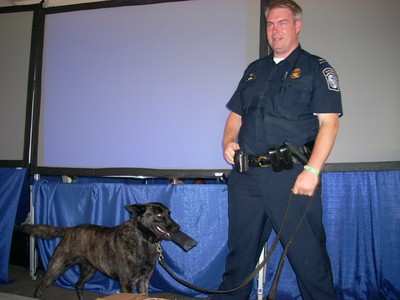Watch Out For Spidey, Ne'er-Do-Wells...
by ANN Correspondent Maxine Scheer
Watch out you high-rolling Tri-Pacer owners, a curious black
Labrador may be sniffing around your aircraft for piles of cash the
next time you fly into Tamiami Airport from Nassau, Bahamas.

Yes, it's true. A dog's keen sense of smell can detect cash,
bombs, food, narcotics, and other prohibited items. These are some
of the specialties that dog in the US Customs and Border Protection
(CBP) Canine Enforcement Unit are trained for as an integral part
of the Agency's agricultural protection, counter-terrorism and
narcotics interdiction strategies.
Attendees at AirVenture 2007 in Oshkosh are being treated to
daily demonstrations at the Federal Pavilion by talented canines,
and their human partners of course, on the Canine Enforcement
Program (CEP).
Aero News attended one of the demonstrations this morning and
met Spidey the Beagle, part of the USDA's Beagle Brigade (with Sara
West, CBP agent, below) and Indy, a narcotics sniffing Dutch
Sheppard (with Tad Dennis, CBP Agent, shown at bottom). Both Spidey
and Dutch enthusiastically demonstrated their superior olfactory
nerves, i.e. good sniffers. Attendees at the demonstration were
told that dogs smell over 44 times better than humans and with the
right temperament and a few months of proper training, can identify
specific scents that can go to the level of differentiating actual
quantities of cash or the individual ingredients in a pepperoni
pizza.

Spidey is a member of the Beagle Brigade, an elite group of
nonaggressive detector dogs and their human partners, founded in
1984, and first used at Los Angeles International Airport. There
are approximately 130 Beagle teams which are used primarily on the
commercial aviation side and stationed at over 60 U.S.
Airports.
 The beagles work between
six and eight flights per day, and sniff travelers' luggage for
prohibited fruits, plants and meat that could harbor harmful plant
and animal pests and diseases. Beagles are very calm, well tempered
animals and are particularly motivated by food. They are rewarded
with special treats when they identify luggage containing a
prohibited item.
The beagles work between
six and eight flights per day, and sniff travelers' luggage for
prohibited fruits, plants and meat that could harbor harmful plant
and animal pests and diseases. Beagles are very calm, well tempered
animals and are particularly motivated by food. They are rewarded
with special treats when they identify luggage containing a
prohibited item.
The larger component of the canine teams is assigned to
narcotics and border protection. With over 1,200 canine teams
deployed in the field, CBP has the largest number of working dog
teams of any federal law enforcement agency. According to CBP's
website, in 2004, CBP Canine teams discovered 1.8 million pounds of
narcotics and assisted in the seizure of approximately 33 million
dollars. The canine units do this with great efficiency. What takes
one dog 20 minutes to inspect, in a warehouse for example, might
take eight inspectors an entire day or more. Using Canines for the
detection of bombs and explosives began approximately two years
ago.
The dogs used for detecting narcotics and other prohibited items
are trained to respond much differently than the beagles. These
dogs are rewarded with play and in appropriate cases, destruction.
While the beagles are taught to sit quietly and gently touch
someone's luggage, the narcotics dogs, like Indy, are trained to
respond swiftly and rewarded for barking and scratching when they
detect what they are trained to find. While aggression is not
tolerated, these dogs are showered with praise and are allowed to
chew on items provided by the handler.
According to CBP, canine units are occasionally called to
inspect GA aircraft, luggage and cargo. Most of the time, GA
inspections are handled by humans. Flights coming from countries
that do not have a land link to the US are of primary concern. This
includes flights from the Caribbean. In cases where agents believe
a situation is high risk, using the canine units to inspect GA
saves time and in some cases, might save an aircraft from having to
be taken apart.

Different breeds are chosen for these dogs and include German
Sheppards, Labradors and pit bulls. Dogs are typically located
through one of three means -- through vendors, from shelters or
through a CBP breeding program. One in every 500 dogs matches the
temperaments CBP is looking for. Once dogs are accepted into the
program, they are sent for approximately two months of training
with their human partner and 80% are estimated to make it through
the program.

The dogs usually start training at one year of age and mandatory
retirement is at age nine. All the dogs, whether they are rescued
from a shelter, donated by their owners, or are part of the
breeding program, find a good home at the end of their career. No
dog is ever sent to an animal shelter. CBP employees adopt many of
the dogs that don't make it though training, and handlers usually
take their retiring canine partner home with them. If there are
opportunities for adopting one of these dogs, anyone interested
would need to contact the Canine Enforcement Training Center in
Front Royal, VA.
 ANN's Daily Aero-Linx (04.13.24)
ANN's Daily Aero-Linx (04.13.24) ANN's Daily Aero-Term (04.13.24): Beyond Visual Line Of Sight (BVLOS)
ANN's Daily Aero-Term (04.13.24): Beyond Visual Line Of Sight (BVLOS) Airborne 04.09.24: SnF24!, Piper-DeltaHawk!, Fisher Update, Junkers
Airborne 04.09.24: SnF24!, Piper-DeltaHawk!, Fisher Update, Junkers Aero-News: Quote of the Day (04.14.24)
Aero-News: Quote of the Day (04.14.24) ANN's Daily Aero-Term (04.14.24): Maximum Authorized Altitude
ANN's Daily Aero-Term (04.14.24): Maximum Authorized Altitude







